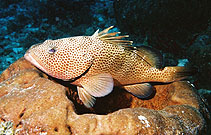http://www.fishbase.org/Summary/speciesSummary.php?genusname=Epinephelus&speciesname=guttatus ---> http://52.67.158.155/Summary/speciesSummary.php?genusname=Epinephelus&speciesname=guttatus
http://52.67.158.155/Summary/speciesSummary.php?genusname=Epinephelus&speciesname=guttatus ---> https://fishbase.net.br/Summary/speciesSummary.php?genusname=Epinephelus&speciesname=guttatus
https://fishbase.net.br/Summary/speciesSummary.php?genusname=Epinephelus&speciesname=guttatus ---> https://fishbase.net.br/summary/Epinephelus-guttatus.html
Epinephelus guttatus, Red hind : fisheries, gamefish
This page is sponsored by
Mundus Maris

Common name (e.g. trout)
Genus + Species (e.g. Gadus morhua)
-

-
About this page
-
Languages
-
User feedbacks
-
Citation
-
Uploads
-
Related species
-


 Red hind
Upload your
photos
and
videos
Red hind
Upload your
photos
and
videos
Pictures
|
Videos |
Sounds
|
Stamps, Coins Misc.
|
Google image
 Epinephelus guttatus
Epinephelus guttatus
Picture by
Bryan, D.
Teleostei (teleosts) >
Perciformes/Serranoidei
(Groupers) >
Epinephelidae
(Groupers)
Etymology:
Epinephelus:
Greek, epinephelos = cloudy (Ref.
45335
)
.
More on author:
Linnaeus
.
Environment: milieu / climate zone / depth range / distribution range
Ecology
Marine; reef-associated; oceanodromous (Ref.
51243
); depth range 100 - ? m (Ref.
89707
). Tropical; 36°N - 8°N, 98°W - 58°W (Ref.
5222
)
Western Atlantic: North Carolina, USA to Paraíba, Brazil (Ref.
57756
). The most common species of
Epinephelus
in the West Indies.
Length at first maturity / Size / Weight / Age
Maturity: L
m
25.0
range ? - ? cm
Max length : 76.0 cm TL male/unsexed; (Ref.
5222
); common length : 40.0 cm TL male/unsexed; (Ref.
5217
); max. published weight: 25.0 kg (Ref.
5217
); max. reported age: 22 years (Ref.
31471
)
Dorsal
spines
(total): 11;
Dorsal
soft rays
(total): 15-16;
Anal
spines
: 3;
Anal
soft rays
: 8. Scales cycloid except for a ctenoid patch of variable size in the pectoral region. Greenish gray to light brown on the back grading to white ventrally, with numerous well-spaced dull orange-red to brown spots on the head, body and fins. Five faint diagonal bars formed by darker spots on the sides. No saddle-shaped blotch on caudal peduncle or along base of dorsal fin (Ref.
26938
); further characterized by having body depth contained 2.7-3.1 times in standard length; head length 2.3-2.4 times in standard length; evenly serrate preopercle, without salient angle; posterior nostril larger than anterior nostril (Ref.
89707
).
Found in shallow reefs and rocky bottoms. Usually solitary and territorial. Feed mainly on crabs (
Calapa
and
Mithrax
) and other crustaceans (alpheid shrimps and scyllarid lobsters), fishes (labrids and haemulids), and octopus. Some undergo sexual inversion at 28 cm TL; most fish larger than 40 cm are males. Important in terms of numbers caught and total weight of landings in the Caribbean. Easily approached by divers (Ref.
9710
). Hermaphrodite species. Excellent food fish (Ref.
26938
). Readily caught on hook and line and easily speared (Ref.
13442
).
Females rest on or close to the bottom, while males patrol around an area that consists of 1 to 5 females and defend this territory from other males. Form aggregation and reproduce almost exclusively within the aggregation period (Ref.
8557
).
Heemstra, P.C. and J.E. Randall
, 1993. FAO Species Catalogue. Vol. 16. Groupers of the world (family Serranidae, subfamily Epinephelinae). An annotated and illustrated catalogue of the grouper, rockcod, hind, coral grouper and lyretail species known to date. Rome: FAO. FAO Fish. Synop. 125(16):382 p. (Ref.
5222
)
IUCN Red List Status (Ref.
130435
)
Least Concern (LC)
; Date assessed:
22 November 2016
CITES
Not Evaluated
Not Evaluated
Threat to humans
Reports of ciguatera poisoning (Ref.
31172
)
Human uses
Fisheries: highly commercial; gamefish: yes
FAO - Fisheries:
landings
; Publication:
search
|
FishSource
|
Sea Around Us
More information
Countries
FAO areas
Ecosystems
Occurrences
Introductions
Stocks
Ecology
Diet
Food items
Food consumption
Ration
Common names
Synonyms
Metabolism
Predators
Ecotoxicology
Reproduction
Maturity
Spawning
Spawning aggregation
Fecundity
Eggs
Egg development
Age/Size
Growth
Length-weight
Length-length
Length-frequencies
Morphometrics
Morphology
Larvae
Larval dynamics
Recruitment
Abundance
BRUVS
References
Aquaculture
Aquaculture profile
Strains
Genetics
Electrophoreses
Heritability
Diseases
Processing
Nutrients
Mass conversion
Collaborators
Pictures
Stamps, Coins Misc.
Sounds
Ciguatera
Speed
Swim. type
Gill area
Otoliths
Brains
Vision
Tools
Bio-Quiz
|
E-book
|
Field guide
|
Identification keys
|
Length-frequency wizard
|
Life-history tool
|
Point map
|
Classification Tree
|
Catch-MSY
|
Special reports
Check for Aquarium maintenance
|
Check for Species Fact Sheets
|
Check for Aquaculture Fact Sheets
Download XML
Summary page
|
Point data
|
Common names
|
Photos
Internet sources
AFORO (otoliths)
|
Alien/Invasive Species database
|
Aquatic Commons
|
BHL
|
Cloffa
|
BOLDSystems
|
Websites from users
|
Check FishWatcher
|
CISTI
|
Catalog of Fishes
:
genus
,
species
|
DiscoverLife
|
ECOTOX
| FAO - Fisheries:
landings
; Publication:
search
|
Faunafri
| Fishipedia |
Fishtrace
| GenBank:
genome
,
nucleotide
|
GloBI
|
GoMexSI
(interaction data)
|
Google Books
|
Google Scholar
|
Google
|
IGFA World Record
|
MitoFish
|
National databases
|
Otolith Atlas of Taiwan Fishes
|
Public aquariums
|
PubMed
|
Reef Life Survey
| Socotra Atlas |
Tree of Life
| Wikipedia:
Go
,
Search
| World Records Freshwater Fishing |
Zoological Record
Estimates based on models
Phylogenetic diversity index (Ref.
82804
): PD
50
= 0.5000 [Uniqueness, from 0.5 = low to 2.0 = high].
Bayesian length-weight: a=0.01175 (0.01037 - 0.01331), b=3.04 (3.02 - 3.06), in cm total length, based on LWR estimates for this species (Ref.
93245
).
Trophic level (Ref.
69278
): 3.8 ±0.3 se; based on diet studies.
Resilience (Ref.
120179
): Medium, minimum population doubling time 1.4 - 4.4 years (K=0.12-0.24; tm=3; tmax=17; Fec=96,000).
Prior r = 0.43, 95% CL = 0.28 - 0.64, Based on 2 stock assessments.
Fishing Vulnerability (Ref.
59153
): Moderate to high vulnerability (52 of 100).
Climate Vulnerability (Ref.
125649
): Very high vulnerability (88 of 100).
Price category (Ref.
80766
):
High
.
Nutrients (Ref.
124155
): Calcium = 21 [10, 46] mg/100g; Iron = 0.452 [0.243, 0.903] mg/100g; Protein = 18.5 [17.0, 19.9] %; Omega3 = 0.126 [0.078, 0.201] g/100g; Selenium = 47.2 [27.8, 83.6] μg/100g; VitaminA = 141 [40, 485] μg/100g; Zinc = 1.15 [0.81, 1.60] mg/100g (wet weight);
Back to Search
Random Species
Back to Top
Accessed through:
Not available
FishBase mirror site :
Laguna, Philippines
Page last modified by :
mrius-barile
|